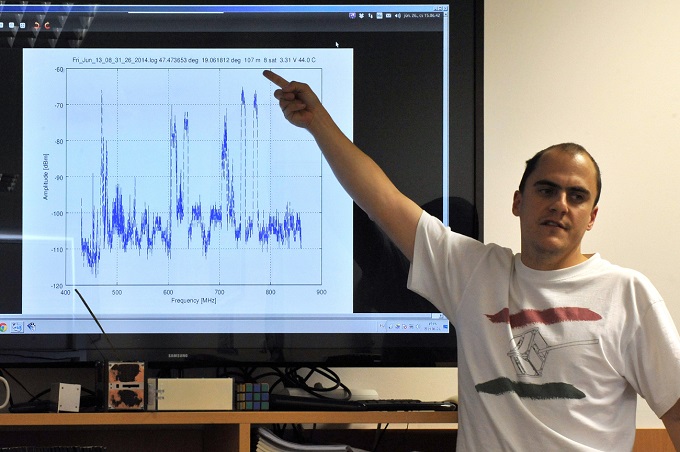News feed
Another Cube of BME Goes to Space
2014. 08. 01.Developers informed Gábor Péceli, Rector of the University of Technology during his visit at the control station of MASAT that BME-1 is being developed to measure electromagnetic radiation in the atmosphere.
„An over 20-year old concept will be realised when the new satellite of the University of Technology is launched and is able to make measurements” emphasized András Gschwindt, retired senior lecturer of the Department of Broadband Infocommunications and Electromagnetic Theory, leader of the development team of MASAT-1 orbiting in the space for 2 years.

The development team announced – in the presence of Rector Gábor Péceli - that their latest development, which was previously called Zsebi-1, was named BME-1 in honour of the University and also presented the plans of the new satellite at the control station.

| The renewed earth station of Masat-1 on the top of E building has had over 200 visitors since its opening in February. It was a special pleasure for the operators of the ground station that about half of the visitors were students of the University and the other half were secondary school students. |
As András Gschwindt says electromagnetic pollution in the atmosphere is mostly caused by radiation emitted by radio and television stations. There have been successful measurements with balloons, as Levente Dudás, assistant lecturer of the Department of Broadband Infocommunications and Electromagnetic Theory presented. At present data is available up to 18kms height in the 400-800 MHz frequency range (this is emitted in the space as well).

According to the plans of the researchers the new, cube-shaped satellite will be launched from 400 km distance from an international space station. The 5x5x5 cm size device, which is smaller than Masat-1, will include a spectrum analyzer to measure electromagnetic emission of TV and radio stations. The development serves scientific (measurement-research) and also educational purposes; it presents what experiment can be made in 5 cm³ size that properly works. There are several satellites in the space in similarly small size but due to various technical problems, like frozen or dead battery, blocked antenna, none of them has worked faultlessly. This is the reason why researchers of the University of Technology would regard it a huge success if they were able to build such a small satellite that perfectly works. Several new students have been involved in the project, who have been asked to provide solutions to ensure smooth operation of the device.
Viktor Józsa, PhD student of the Department of Energy Engineering has been invited to participate in the project by Gábor Stépán (Department of Applied Mechanics) and Gyula Gróf (Department of Energy Engineering) department leaders. As he has always been interested in space research as one of his hobbies, he felt very delighted to be able to join the team and he encouraged his students to do the same. One of them, Péter Török, third year mechanical engineering student is responsible for the thermotechnology and mechanical aspects: he does orbit simulation with the help of the Department of Applied Mechanics and develops a heat transfer network model for that. “In case of such a small satellite the temperature of the battery is crucially important and therefore complicated heat loss calculations are required to ensure that the temperature of the battery remains above 0°C. This is a great engineering challenge and innovation at the same time because at present there is no proven solution for this problem,” explained Viktor Józsa.

Vivien Ötvös, second year mechanical engineering student was invited in the team by her class- and roommate, Krisztina Katona they are both in charge of designing the construction of the satellite. The will prepare a 3D model of the device, which will have to include dissipative elements to make rotation of the object slower. “This is necessary because in case the satellite has fast rotation reaching the critical 100 turn/second angular speed, the solar panels cannot function properly and therefore the control system will not be able to load the battery or the circuits” Viktor Józsa highlighted a significant problem. The two students will be responsible for preparing the technical drawings necessary for production and also the thermotechnical measurements of the items produced.
The young students find development work very exciting and complex as a series of mechanical and energetic issues are to be addressed and solved. They are planning to publish certain scientific problems and results in student research studies (TDK papers’ competition) in the next academic year. “As they are required to record everything it will not be difficult to prepare the studies for the competition, which should bring very good results for them,” said Viktor Józsa. “These topics are not part of the general university education but the theoretical background that leads to the solutions is covered in the university courses. The missing elements the students have to find and elaborate according to relevant findings in international scientific literature,” he added.

The team has 20 members including the mechanical and electrical engineering experts. “The cost of launching the satellite is some 15.000 Euros and another 10-15 million Hungarian Forints is required for the development work,” calculated András Gschwindt. “The National Media and Infocommunications Authority has already contacted us to offer sponsorship for the project. There is a great amount of superfluous radiation getting into the space. We intend to draw attention to this fact as electromagnetic radiation is a kind of pollution, just like carbon dioxide, carbon monoxide or nitrogen oxide, which burning of fossil fuels produce,” András Gschwindt emphasized.
-BK-
Photo: János Philip
